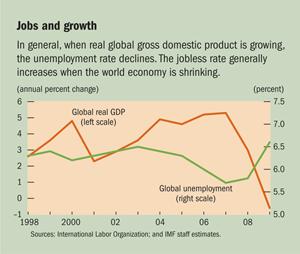Unemployment: The Curse of Joblessness
Finance & Development
The number of people at work is generally closely related to whether an economy is growing at a reasonable rate

There must be an app for this (photo: Susana Vera/Reuters/Corbis)
At the peak of the worldwide recession that began in 2008, the International Labor Office announced that global unemployment reached the highest level on record. More than 200 million people, 7 percent of the global workforce, were looking for jobs in 2009.
It is not a coincidence that the global economy experienced the most severe case of unemployment during the worst economic crisis since the Great Depression. Unemployment is highly dependent on economic activity; in fact, growth and unemployment can be thought of as two sides of the same coin: when economic activity is high, more production happens overall, and more people are needed to produce the higher amount of goods and services. And when economic activity is low, firms reduce their workforce and unemployment rises. In that sense, unemployment is countercyclical, meaning it rises when economic growth is low and vice versa.
But unemployment does not fall in lockstep with an increase in growth. It is more common for businesses to first try to recover from a downturn by having the same number of employees do more work or turn out more products—that is, to increase their productivity. Only as the recovery takes hold are businesses likely to add workers. As a consequence, unemployment may start to come down only well after an economic recovery begins. The phenomenon works in reverse at the start of a downturn, when firms would rather reduce work hours, or impose some pay cuts before they let workers go. Unemployment starts rising only when the downturn is prolonged. Because unemployment follows growth with a delay, it is considered a lagging indicator of economic activity.
How sensitive is the unemployment rate to economic growth? That depends on several factors, most notably on labor market conditions and regulations. One estimate of the strength of this relationship for the U.S. economy comes from Okun’s Law (named after the late U.S. economist Arthur Okun), which postulates that a decline in unemployment by 1 percentage point corresponds to a 3 percent rise in output. More recent estimates find that the consequent rise in output may be lower, possibly between 2 and 3 percent.

How far does this inverse relationship between growth and unemployment go? If economies kept expanding, would one expect to see unemployment disappear altogether? Actually this is not the case (see chart); even in the 2000s, when the global economy was prospering (at least until the crisis), global unemployment declined but never reached zero. This observation raises the question, why can unemployment never fall to zero?

Clearing the market
According to classical economic theory, every market, including the labor market, should have a point at which it clears—where supply and demand are equal. Yet the very existence of unemployment seems to imply that in labor markets around the world, the demand for and supply of labor fail to reach an equilibrium. Do labor markets continually fail?
Sometimes it is a matter of wages, or the unit price of labor, not adjusting to clear the market. Some workers, particularly skilled ones, may have reservation wages below which they are not willing to work, but which are higher than what employers are willing to pay. Alternatively, the wage an employer is willing to pay may be lower than the legal minimum wage set by governments to try to ensure that wages can sustain a living. When such rigidities in the labor market lead to a shortage of jobs, it creates structural unemployment, and those who are structurally unemployed tend to have longer spells of joblessness, on average.
But the inflexibility of wages does not fully explain the perennial nature of unemployment. Some level of unemployment will always exist for no other reason than that there always will be some people who are between jobs or just starting out their careers. These people are unemployed not because there is a shortage of jobs in the market, but because finding a job takes time. Such temporary spells of unemployment are referred to as frictional unemployment.
The combination of these factors brings about a long-term average around which the unemployment rate tends to fluctuate, called the natural rate of unemployment (NRU). The term “natural” does not mean it is a given that cannot be changed; to the contrary, it implies that labor market characteristics, which are mostly driven by policies, determine it. For example, the relatively high rate of unemployment in Europe compared with the United States is in part attributed to Europe’s stronger unions and stricter labor regulations. These labor market institutions may give European workers a better bargaining position, but they can also render workers too expensive for employers. In the United States, unionization is lower and labor markets are more flexible, but workers have traditionally enjoyed higher employment rates than their European counterparts.
The natural rate of unemployment is sometimes called the nonaccelerating inflation rate of unemployment (NAIRU), because it is consistent with an economy that is growing at its long-term potential, so there is no upward or downward pressure on inflation. The flip side of this argument suggests that whenever unemployment temporarily deviates from the NAIRU, inflation is affected. Consider a recession, a period of low economic activity. With lower demand for goods and services, firms start laying off workers and at the same time refrain from raising prices. So unemployment rises and inflation falls during recessions. This trade-off between unemployment and inflation—described by the Phillips curve (named after the late New Zealand economist William Phillips)—is only temporary, though; once prices adjust to a new equilibrium that clears the goods and services market, firms go back to producing at full capacity and unemployment once again falls—to the NAIRU.
Understanding what is behind the long-term equilibrium rate of unemployment helps policymakers understand how they can, and cannot, change it. For example, policies that try to lower unemployment by boosting consumer demand (thereby raising production) can do so only temporarily, and at the cost of higher inflation later. However, policies that are geared toward easing frictional or structural unemployment can boost employment without necessarily affecting inflation.
But the NAIRU can also change over time without any explicit policy action: structural changes such as technological advances and demographic shifts can have long-lasting effects on unemployment trends. For example, many economists agree that the technology boom of the 1990s increased labor productivity, making each worker more “desirable” to employers, and has therefore reduced the NAIRU—although there was an initial blip of unemployment as workers untrained in the technologies were displaced. A rapidly aging population—as is occurring in many advanced economies today—also countributes to fewer people in the job market and lower unemployment.
Measuring unemployment
Not all people who don’t work are unemployed. To be considered unemployed for government statistics, a person must not only be out of work, but also be actively looking for a job—for example, by sending out resumes. In the United States unemployment is measured by a monthly survey of households conducted for the Bureau of Labor Statistics and covers a representative sample of more than 100,000 individuals. The labor force includes both those with jobs and those looking for them. The unemployment rate is the percentage of the labor force that is looking for a job. The labor force is only a portion of the total population. The ratio of the labor force to the working-age population is called the labor force participation rate.
The labor force excludes people who are of working age but are neither employed nor looking for a job—such as students and homemakers. But the labor force also leaves out jobless people who were in the job market unsuccessfully for so long that they stopped looking for a job. Such discouraged workers are one reason why unemployment statistics can underestimate the true demand for jobs in an economy. Another form of hidden unemployment in statistics comes from counting as employed anyone who did any work for pay (or profit, if self-employed) in the week before the government survey. This hides the demand for work by people who would prefer full-time employment but cannot find it.
Reference
International Labor Office, Global Employment Trends, January 2010.
Updated: Cannot perform flastmod(): Win32 Error Code = 2


